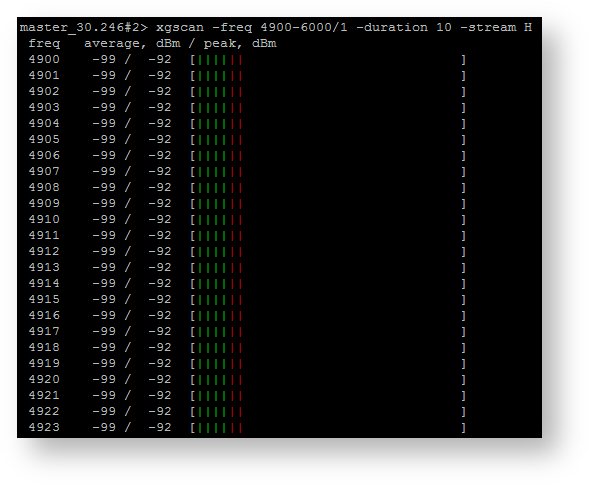...
| Code Block |
|---|
|
#xgscan usage:
xgscan -freq {<freq_start>[-<freq_end>[/<step>]],...}
xgscan -rx-input {a, b, c}
xgscan -duration {10...10000}
xgscan -last
xgscan -last [-web]
xgscan -stream {V, H}
xgscan -capabilities |
...
Commands and options description is given in the table below
| Center |
|---|
| Scroll Title |
|---|
| title | Table - "xgscan" arguments commands and options description |
|---|
| | Command | Description |
|---|
xgscan -freq {<freq_start>[-<freq_end>[/<step>]],...} | - Fist (minimum) and last (maximum) frequency for scanning, scanning frequency step
- It is recommended to set 1 MHz step value to get the more precise scanning results. Please note, the smaller the step, the more time it takes to scan. In order to detect the interference it is sufficient to set the step equal to the used bandwidth
| xgscan -duration {10...10000} | - Scanning duration of one frequency in milliseconds
| xgscan -last | - Final scanning results (stored until the reboot). From firmware version "v1.6.7" results available after reboot
| | xgscan -last [-web] | - Final scanning results from web interface (stored until the reboot). From firmware version "v1.6.7" results available after reboot
| xgscan -stream {V, H} | - Polarization:
- "V" - vertical
- "H" - horizontal
| xgscan -capabilities | - List of parameters available for using during scanning
- "available freq" - available frequency range
- "steps for web" - scanning frequency step for web-interface
- "bands for web" - bandwidth for web-interface
- "grid width" - bandwidth value for the highlighted frequency channel
- "all available freq for use" - all available frequencies for use
|
|
|
| Center |
|---|
| Scroll Title |
|---|
| title | Figure - "xgscan" output example |
|---|
| 
|
|
...
